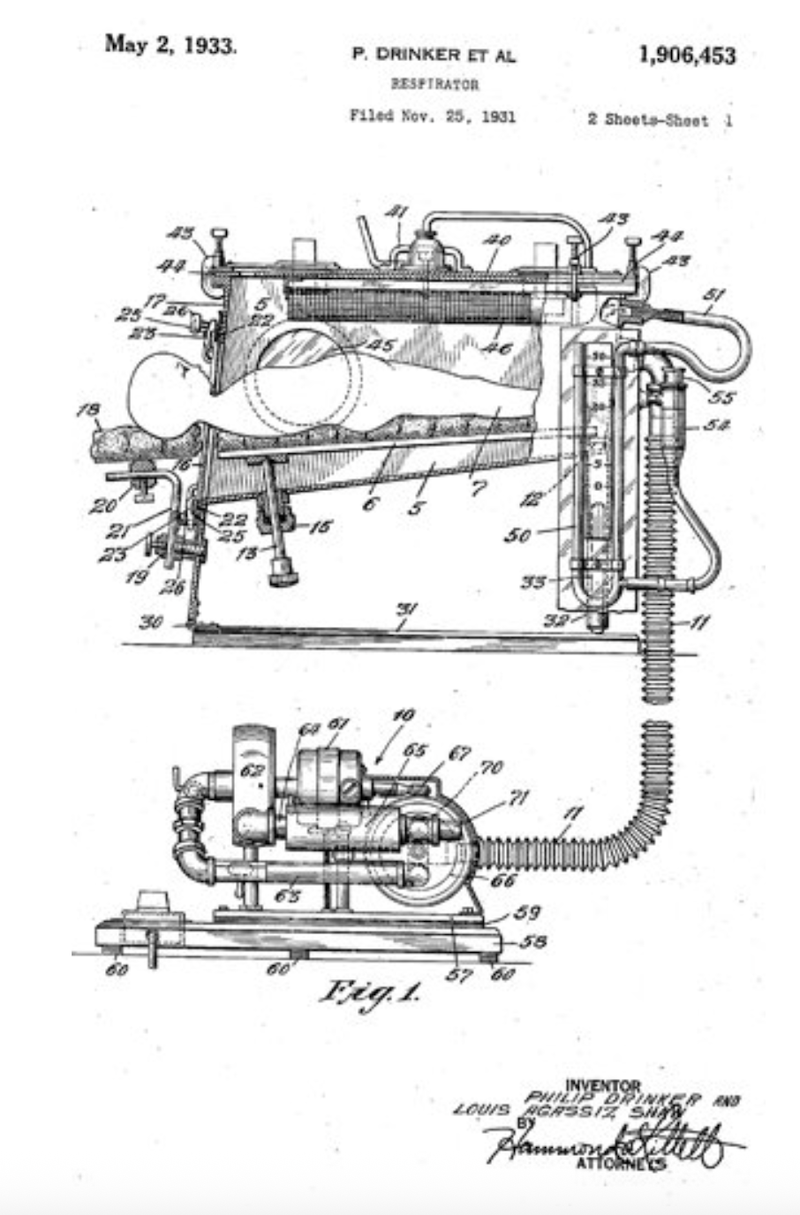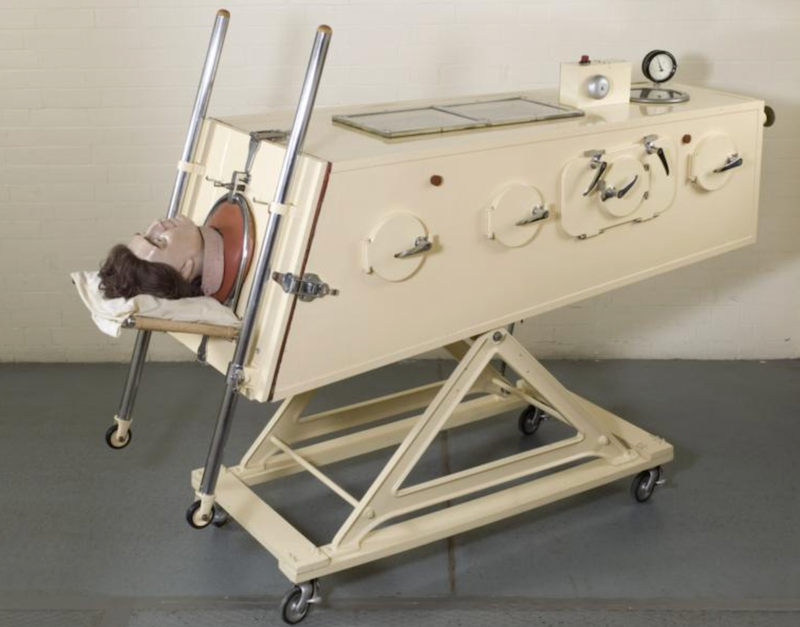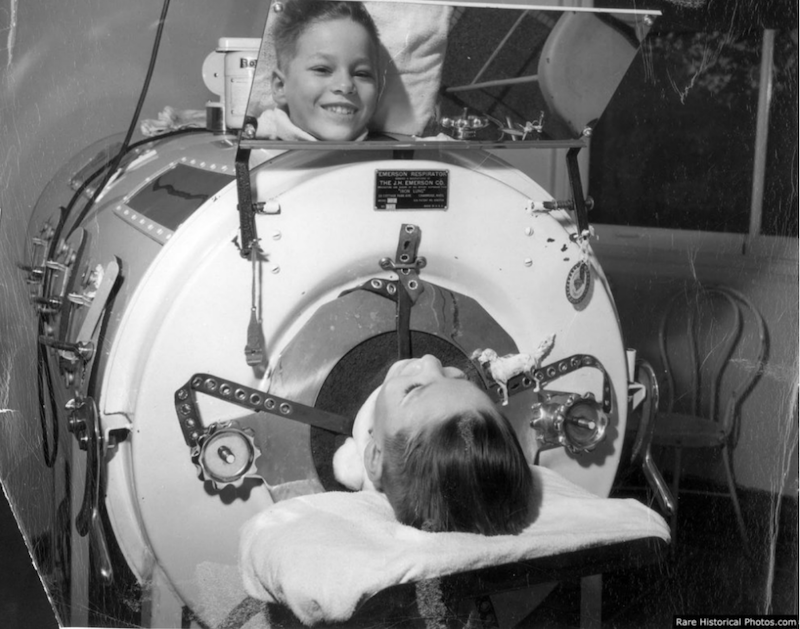The History of the Iron Lung
- FibonacciMD

- Jul 24
- 6 min read
Updated: Dec 16
Lifesaving Innovation: The Story of the Iron Lung
Discover the compelling history of the iron lung, from its 1928 invention to its role in combating polio and revolutionizing respiratory care.

By Stuart M. Caplen, MD
Polio has probably been around for millennia, but was not formally recognized as a disease condition until 1840. In the early 1900s to the 1950s, American parents lived in perpetual fear that their child might develop polio during an epidemic. Polio’s more scientific name is poliomyelitis, and it was previously also known as infantile paralysis. Polio, caused by the poliovirus, is a disease that can lead to various clinical outcomes. It can be mild with only flu-like symptoms, cause paralysis or weakness in one limb, or cause diffuse paralysis. In its most serious form, patients can develop diffuse muscle paralysis, including involvement of the respiratory muscles, which can lead to an inability to breathe. The disease peaked in the U.S. in 1952 with over 57,000 cases and over three thousand deaths that year. The iron lung was a major medical advance that allowed individuals with neuromuscular diseases such as polio to breathe.
The First Iron Lung
The iron lung was first invented by Philip Drinker and Louis Agassiz Shaw at the Harvard School of Public Health. It was essentially an airtight metal box that, by creating negative and positive pressure within it, could expand and contract a patient’s chest wall and lungs when that person could not breathe on their own (a process known as external negative pressure ventilation). The original version was powered by two electric vacuum cleaner motors that moved a bellows back and forth, creating negative and positive pressures in the apparatus. It was initially called the Drinker and Shaw respirator. The only thing protruding out of the box was the patient’s head, with a rubber collar around the neck to provide an airtight seal.

The First Patients
After some initial testing on cats, the first patient an iron lung was ever used on was an 8-year-old girl, Bertha Richard, at Children’s Hospital in Boston in October 1928. She had been sick with polio for three days and was having difficulty breathing. Her respiratory diaphragm, the muscle that helps expand and contract the lungs, was affected. Her pediatrician contacted Drinker and Shaw to see if she could be helped. While in the hospital, she struggled to breathe, and her fingertips and lips turned blue from lack of oxygen. She was placed in the iron lung, and the pressure created by the machine varied from a negative 30 cm of water to expand the chest wall and lungs, followed by a positive pressure of 15 cm of water to contract the chest wall and the lungs during exhalation. Fifteen minutes after entering the Drinker and Shaw respirator, she was significantly improved and asked for ice cream. However, despite the respiratory assistance, she died of pneumonia five days later. The experiment was still considered a success, as her breathing had dramatically improved, and she was kept alive for five days. It was pneumonia that had caused her death, not polio.
One of the next patients, Barrett Hoyt, was a Harvard University student who had contracted polio. He was admitted, gasping for air, to Peter Bent Brigham Hospital on September 13, 1929. Within a short time after entering the iron lung, he gratefully said, “I breathe.” He later went on to fully recover. This event, and other polio survivors helped by the iron lung (as it was now called) caught the public’s attention, as respiratory failure from polio was no longer a guaranteed death sentence.
Upgraded Models
The initial models were loud and cumbersome. To bathe a patient, a team of six people had to work quickly. The patient was slid out of the apparatus and washed while they were not breathing, and then put back in before turning blue from lack of oxygen.
In 1931, John Haven Emerson improved the design and added portholes on the side to allow access to the patient’s body without losing air pressure. He also made the bed slide out of the machine, which allowed easier patient entrance and egress.
Emerson was sued by Drinker and Harvard for patent violation. In the litigation, a judge ruled that all of the technology used by Drinker and Shaw was already in existence before their invention, and Emerson won the case when the judge ruled that all the patents were invalid.

In 1937, during an Australian polio epidemic, the cost of shipping and buying a Drinker Respirator from America was so high that the health department asked a bioengineer, Edward Both, to come up with a less expensive alternative. He devised the Both Respirator, which was constructed of plywood rather than metal and still functioned properly.
Length of Iron Lung Therapy
A patient might require weeks or months of being in an iron lung until the polio symptoms resolved. For some, their respiratory muscles never recovered, and they required lifelong iron lung therapy. Patients recovering from polio would spend some time out of the iron lung to help build up their respiratory muscles and then be put back in when they tired. Later in their recovery, they just might be in the apparatus overnight until they fully recovered.

Portable Iron Lungs
Over time, portable iron lungs were invented, which consisted of a metal or plastic apparatus that covered only the chest. By changing the air pressure from positive to negative around the chest, this equipment could help patients to breathe. It permitted the rest of the body to be uncontained and was a major improvement over the original iron lung.
Decreased Use of the Iron Lung
In the 1950s, the need for iron lung therapy markedly decreased. In 1955, the Salk polio vaccine was released and approved for use. By 1961, the vaccine was so successful there were only 161 new polio cases in the U.S. In 1957, the first modern respirator, the Bird Mark 7, was invented by Forrest Bird, which helped revolutionize the way people with respiratory paralysis could be managed.
Paul Alexander, the Longest Surviving Iron Lung Patient
The Guinness World Records has recognized Paul Alexander as the longest-living iron lung patient in history. He had been paralyzed by polio at age six and used an iron lung until he died in 2024 at the age of 78. He had learned a process called glossopharyngeal breathing, where, using his throat muscles, he swallowed air one mouthful at a time and then pushed the air down his throat into his lungs. Paul could eventually leave the iron lung for hours at a time until he got too tired or needed to sleep. He attended college, using his iron lung in his dormitory room and going by wheelchair to attend classes while using his breathing technique. Paul was able to achieve both a college and a law degree and did actively practice law, sometimes seeing clients while in an iron lung in his office.
______________________________________________________________________________________
You may also be interested in reading the fascinating story of the Coney Island Amusement Park Incubator Babies or The History of the Electrocardiogram (EKG/ECG) .
______________________________________________________________________________________
References
The Iron Lung. 14 October 2018. Science Museum. Retrieved from: https://www.sciencemuseum.org.uk/objects-and-stories/medicine/iron-lung
Wunsch H. Book Excerpt: How the Iron Lung Transformed Polio Care. Undark. 23 May 2023. Retrieved from: https://undark.org/2023/05/19/book-excerpt-how-the-iron-lung-transformed-polio-care/ from Wunsch H. The Autumn Ghost: How the Battle Against a Polio Epidemic Revolutionized Modern Medical Care. May 9, 2023. https://www.amazon.com/Autumn-Ghost-Against-Epidemic-Revolutionized/dp/1771649453/ref=tmm_hrd_swatch_0?_encoding=UTF8&qid=&sr=
Rizzo J. Flashback: Iron Lung. Pfizer. https://www.pfizer.com/news/articles/flashback_iron_lung
History of the Polio Vaccine. WHO. Retrieved from: https://www.who.int/news-room/spotlight/history-of-vaccination/history-of-polio-vaccination
Westhorpe RN, Ball C. Anaesthesia and Intensive Care, Vol. 40, No. 4, July 2012.Retrieved from: https://journals.sagepub.com/doi/pdf/10.1177/0310057X1204000401
Falcon J, Miles JD, Mugavero A. Paul Alexander, 78-year-old Dallas man who lived in an iron lung for most of his life, dies. CBS News Texas. Updated on: March 13, 2024. https://www.cbsnews.com/texas/news/paul-alexander-78-year-old-dallas-man-who-lived-in-iron-lung-for-most-of-his-life-dies/
Snowdon C. The man in the iron lung: How Paul Alexander lived life to the full. BBC News. 23 March 2024. Retrieved from: https://www.bbc.com/news/health-68627630
Pilastro E. Longest surviving iron lung patient was kept alive by a machine for 70 years. 21 March 2023. Guinness World Records. Retrieved from: https://www.guinnessworldrecords.com/news/2023/3/meet-longest-surviving-iron-lung-patient-kept-alive-by-a-machine-for-70-years-741881
Photos
Iron lungs for polio victims, 1930s-1950s. Rare Historical Photos. Updated on: November 16, 2021. https://rarehistoricalphotos.com/iron-lungs-polio-1930s-1950s/
Healey J. The Both Brothers and the "Iron Lung”. South Australian Medical Heritage Society Inc. 1998. Retrieved from: https://www.samhs.org.au/Virtual%20Museum/Medicine/Bothurinlung/bothironlung-netley.html